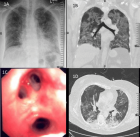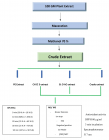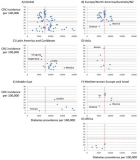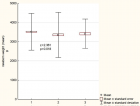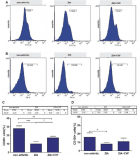Table of Contents
Congenital Dysfibrinogenaemia: A Family Case Report
Published on: 3rd December, 2024
Congenital fibrinogen qualitative disorders, including dysfibrinogenemia and hypo-dysfibrinogenaemia, are highly heterogeneous, both in clinical manifestation and for the mutational molecular spectrum driving these disorders. Correlations between phenotype and genotype remain poorly defined. Considerable work lies ahead in order to achieve diagnostic and prognostic precision and subsequently provide targeted management for this rare disease. Here we report the laboratory test, the clinical and molecular characterisation of a family with dysfibrinogenemia.
Treatment Options for Congenital Dyserythropoietic Anemias (CDAs): Advances in Bone Marrow Transplantation, Gene Therapy, and Targeted Therapies
Published on: 30th November, 2024
Congenital Dyserythropoietic Anaemia (CDA) is a rare genetic disorder that affects the maturation of red blood cells. The disorder is classified into different types, with a prevalence ranging from 1 in 100,000 to 1 in 1,000,000 individuals. Treatment strategies are designed with the primary focus on symptom management, the prevention and treatment of complications, and the underlying disease pathophysiology. The advent of bone marrow transplantation, gene therapy, and targeted therapies has considerably expanded the scope for therapeutic intervention in CDAs. Supportive care, including blood transfusions and iron chelation therapy, has demonstrated efficacy in managing iron overload and improving overall survival rates. The potential of gene therapy, targeted therapies, and hematopoietic growth factors in the treatment of CDA is currently being investigated. Further research and clinical trials are required to develop more effective and personalized therapeutic interventions.
Carfilzomib Induced Cardiac Tamponade - A Case Report
Published on: 25th June, 2024
Carfilzomib, a highly selective proteasome inhibitor, is commonly used in the treatment of multiple myeloma and AL amyloidosis. While its efficacy is well-established, there is increasing recognition of its association with cardiovascular adverse events, including hypertension, heart failure, and arrhythmias. However, cases of carfilzomib-induced pericardial disease remain rare. Here, we present a case of a 78-year-old female with multiple myeloma who experienced two episodes of hemorrhagic pericardial effusion following carfilzomib therapy, highlighting the importance of vigilant cardiovascular monitoring during treatment.
Assessment of Redox Patterns at the Transcriptional and Systemic Levels in Newly Diagnosed Acute Leukemia
Published on: 29th April, 2024
Background: Acute leukemia is the result of clonal transformation and proliferation of a hematopoietic progenitor giving rise to poorly differentiated neoplastic cells. Reactive oxygen species play a role in maintaining the quiescence, self-renewal, and long-term survival of hematopoietic stem cells, but it is unclear how they would affect disease onset and progression. The aim is to evaluate, at the transcriptional and systemic level, the oxidative-inflammatory status in newly diagnosis acute leukemia patients. Methods: Seventy acute leukemia patients [26 acute lymphoblastic leukemia (ALL), 13 Acute Promyelocytic Leukemia (APL), and 31 Acute Myeloid Leukemia (AML)] and forty-one healthy controls were analyzed. Malondialdehyde and catalase activity were evaluated. Gene expression of NRF2, SOD, PRDX2, CAT, IL-6, and TNF-α was analyzed by real-time PCR.Results: Malondialdehyde concentration was similar in all groups studied. Catalase activity was significantly higher in AML and APL patients compared to controls, while ALL showed similar activity to the healthy group. NRF2, CAT, and PRDX2 expression levels were similar between groups, SOD expression was downregulated in all acute leukemia patients. TNF-α expression was lower in AML groups than in healthy individuals, and IL-6 mRNA expression was downregulated in ALL and APL.Conclusion: This is the first report that correlates transcriptional and systemic parameters associated with the oxidative inflammatory status in newly diagnosed acute leukemia. Some of the parameters evaluated could be used as biomarkers in the selection of an effective therapeutic strategy and will open new directions for the follow-up and evolution of this disease.
The Outcome of Patients with Leukemia Presenting with Hyperleukocytosis Requiring Leukapheresis. The Experience of King Fahad Specialist Hospital in Dammam, Saudi Arabia
Published on: 15th March, 2024
Background: Patients with acute and chronic leukemia presenting with hyperleukocytosis are at risk of developing leukostasis which has serious and life-threatening complications. Leukapheresis is usually performed to reduce the complications of leukostasis in patients presenting with hyperleukocytosis and clinical manifestations compatible with leukostasis. Methods and materials: A retrospective study of patients with acute and chronic leukemia who received leukapheresis for hyperleukocytosis between the 1st of January 2013 and the 31st of December 2023 at King Fahad Specialist Hospital (KFSH) in Dammam, Saudi Arabia was performed. Results: Over a period of 11 years, a total of 50 patients with acute and chronic leukemia presenting with hyperleukocytosis and clinical manifestations of leukostasis; 32 patients with acute leukemia (AL) and 18 patients with chronic myeloid leukemia (CML); received leukapheresis at our institution. Among the 32 patients with AL who received leukapheresis, 24 patients (75%) had acute myeloid leukemia (AML), 7 patients (21.88%) had acute lymphoblastic leukemia (ALL) and 1 patient (3.13%) had bilineage acute leukemia (BAL). At presentation of their AL: 3 patients (9.38%) had fever, 9 patients (28.13%) had infections, 4 patients (12.5%) had palpable spleen or liver, 6 patients (18.75%) had palpable external lymph nodes, and 9 patients (28.13%) had extramedullary disease (EMD). After receiving induction and consolidation cycles of chemotherapy, 11 patients (34.38%) of AL patients received allogeneic hematopoietic stem cell transplantation (HSCT). At the end of the follow-up, 17 patients (53.1%) with AL were alive while 15 patients (46.9%) were dead. The 8-year overall survival (OS) for all patients with AL subjected to leukapheresis was 47%. The 5 years OS for patients with AL who subsequently received HSCT and those who did not receive allogeneic HSCT were 70% and 40% respectively. The mean white blood cell (WBC) count of CML patients subjected to leukapheresis was 465.5 × 109/L, 11 patients (61.11%) had clear signs of leukostasis, and 8 patients (44.44%) had splenomegaly at presentation. Regarding the disease stage at presentation, 14 CML patients (77.78%) had chronic phase (CP), 2 patients (11.11%) had accelerated phase (AP) and 2 patients (11.11%) had blast phase (BP). Regarding the fate of CML patients at the end of the study were: 15 (83.33%) were alive, 1 (5.56%) dead, and 2 (11.11%) were unknown as they lost follow-up. However, the 10-year OS of patients with CML subjected to leukapheresis was 90%. Conclusion: Patients with acute or chronic leukemia presenting with hyperleukocytosis and either ongoing or impending leukostasis should have urgent cytoreductive chemotherapy and leukapheresis to prevent life-threatening complications. Although the outcome of AL patients presenting with leukostasis is generally poor, prompt cytoreductive therapy and leukapheresis, followed by induction chemotherapy and allogeneic HSCT may improve the outcome. Also, urgent cytoreduction including leukapheresis improves the outcome of patients with CML presenting with hyperleukocytosis and leukostasis.
Myeloid Neoplasms: Better Understanding of their Molecular Pathogenesis with Improvised Genomic Testing: A Ray of Hope for Better Clinical Outcomes
Published on: 31st January, 2024
With the increase in incidence and prevalence of myeloid neoplasms in India, it has become a necessity to understand its molecular mechanisms, acquisition of genomic alterations, and understand its primary and secondary resistance pathways which ultimately impact the decision of therapeutics. The objective of this review is to investigate the molecular aspects of this disease type and identify the biomarkers that help with diagnosis, risk assessment, prognosis, and selecting the best line of treatment for a specific myeloid neoplasm. Advancements and innovations in molecular technologies from simplest Real-Time PCR to high throughput next-generation sequencing have played a vital role in screening the most common mutations and fusions to the novel and rare. Molecular technologies have helped to enumerate the genomic landscape of myeloid malignancies. The understanding of both- the mechanisms and the technology is a strong combination as it has helped revolutionize precision oncology and helped in giving better therapeutic choices with better clinical outcomes. The importance of cellular morphology, clinical symptoms, and molecular pathology in assessing the risk of myeloid malignancies is emphasized and summarized in the review. The review concludes that understanding molecular pathogenesis can be improved by using clinical-pathological-molecular strategies for diagnosis and therapy decision-making.

HSPI: We're glad you're here. Please click "create a new Query" if you are a new visitor to our website and need further information from us.
If you are already a member of our network and need to keep track of any developments regarding a question you have already submitted, click "take me to my Query."






